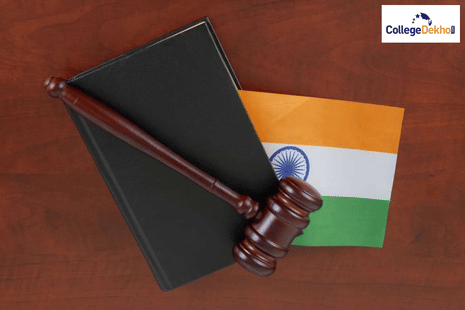
The effective analysis of Judges' views is a key skill that CLAT aspirants must master because it enhances their legal reasoning, understanding, and application. The opinion of the Judges can give the reason as to why certain verdicts were made, how statutes were interpreted, and how legal principles changed over time, and this is the information that is very important in solving legal reasoning and current affairs questions in
CLAT 2026
. It is a step-by-step guide on can you dissect Judges' opinions using real case situations that can make an opinion sound more practical and effective.
Also Check -
Effective CLAT 2026 Preparation Strategies for Students with Learning Disabilities
How to Analyse Judges’ Opinions Using Real Case Examples for CLAT 2026
Judges’ opinions generally follow a structured format, and you can understand this format by looking at the following key points below:
Facts of the Case: Identify the key facts forming the backdrop.
Issues: Focus on specific legal questions the court is addressing.
Arguments: Note the arguments presented by both sides.
Judgement and Reasoning: Understand how the Judge applies laws and legal principles to the facts.
Conclusion: The final decision or ruling.
Check the other tips below to understand the Judge’s opinion using a real case example for CLAT below in the article.
Quick Links:
| CLAT sample papers | CLAT practice tests |
|---|---|
| CLAT 2026 syllabus | CLAT previous year question papers |
Use Landmark Cases to Practice
The analysis of outstanding Indian cases facilitates understanding of judicial reasoning and the setting of precedents. For example:
Kesavananda Bharati vs. State of Kerala (1973): A 13-Judge bench ruled that Parliament cannot alter the “basic structure” of the Constitution. Focus on the Judges’ divergent opinions, revealing constitutional limits on legislative power.
Maneka Gandhi vs. Union of India (1978): Expanded the scope of the Right to Life and Personal Liberty under Article 21. Study how the court interpreted “procedure established by law” to include fairness and reasonableness, demonstrating judicial activism.
Shreya Singhal vs. Union of India (2015): Struck down Section 66A of the IT Act for being unconstitutional, showing judicial protection of free speech.
Analysing Judges’ reasoning in these cases shows their approach to balancing competing rights and principles, informing how to approach legal reasoning questions.
Also Check -
Common Logical Reasoning Mistakes in CLAT and How to Tackle Them
Break Down Opinions with Highlighting and Notes
Highlight key phrases, legal maxims, and statutory interpretations while reading opinions. Create summary notes focusing on:
The legal principle being laid down
The Judge’s reasoning pathway
How facts are linked to the ruling
This distillation helps in quick revision and better retention of essential points.
Compare Different Judges’ Opinions in Split Verdicts
In cases with multiple opinions or dissent, compare how different Judges reasoned:
Who emphasised strict textual interpretation?
Who preferred a purposive or liberal interpretation?
How did dissenting opinions challenge the majority ruling?
For example, in Kesavananda Bharati, contrasting opinions elucidate different theories of constitutional law, enriching your understanding beyond just the verdict.
Quick Links:
| CLAT 2026 exam pattern | Best books for CLAT 2026 preparation | How to prepare for CLAT |
|---|
Apply Judges’ Reasoning to Hypotheticals
Test your comprehension by applying judicial reasoning to hypothetical scenarios or new facts. This exercise mirrors CLAT’s legal reasoning passages, which often present a principle and a fact pattern requiring application. For instance, after studying Maneka Gandhi, consider whether a law restricting personal freedom without a reasonable procedure would pass judicial scrutiny. This prepares you for questions on statutory interpretation and constitutional rights.
Use Summaries and Judgement Digests
Leverage websites like SCC Online, LiveLaw, or Supreme Court Observer for summarised judgements and key takeaways. These summaries save time and highlight judicial reasoning, allowing focused study rather than reading lengthy texts.
Through the systematic dissection of Judges' opinions employing these steps and using real case scenarios, CLAT applicants stand a chance to enhance their legal knowledge, polish their analysis skills, and feel comfortable in approaching questions of legal reasoning. The skill not only boosts the level of performance in exams but also forms the basis of future study and practice of law.
Related Articles
For any query, head to our QnA Zone or fill out our Common Application Form . Stay tuned to CollegeDekho for more such updates!
Are you feeling lost and unsure about what career path to take after completing 12th standard?
Say goodbye to confusion and hello to a bright future!

FAQs
Highlight key points and legal maxims, and write concise notes emphasising core legal principles and conclusions.
Compare majority and dissenting opinions to analyse different interpretations and reasoning strategies.
Landmark cases provide practical context to abstract legal principles and show diverse judicial approaches, enriching understanding.
Focus on the facts of the case, legal issues, arguments by parties, judges’ reasoning, and final verdict.
Understanding judges' reasoning helps in mastering legal principles and improves legal reasoning skills essential for CLAT.
Was this article helpful?




















Similar Articles
AIBE Question Trends Decoded Through Sample Paper Analysis
How to Tackle Multi-Layered Critical Reasoning Questions in CLAT 2026
How to Crack If-Then Questions in CLAT 2026 Conditional Reasoning
How to Use Logic to Eliminate Incorrect Answers in CLAT 2026
How to Tackle Unconventional Questions in CLAT 2026 Logical Reasoning
CLAT 2026 Cutoff for NLU Bangalore